|
The Search
for Hatshepsut and the Discovery of her Mummy
Dr. Zahi Hawass
June 2007
When the Discovery Channel approached me to search for the mummy of Queen
Hatshepsut, I did not really think I would be able to make a definite
identification. But I did think that this would give me the perfect
opportunity to look at the unidentified female mummies from Dynasty 18,
which no one had ever studied in as a group. There were already many
theories about the identities of these mummies, but the latest scientific
technology had not yet been used to study them.
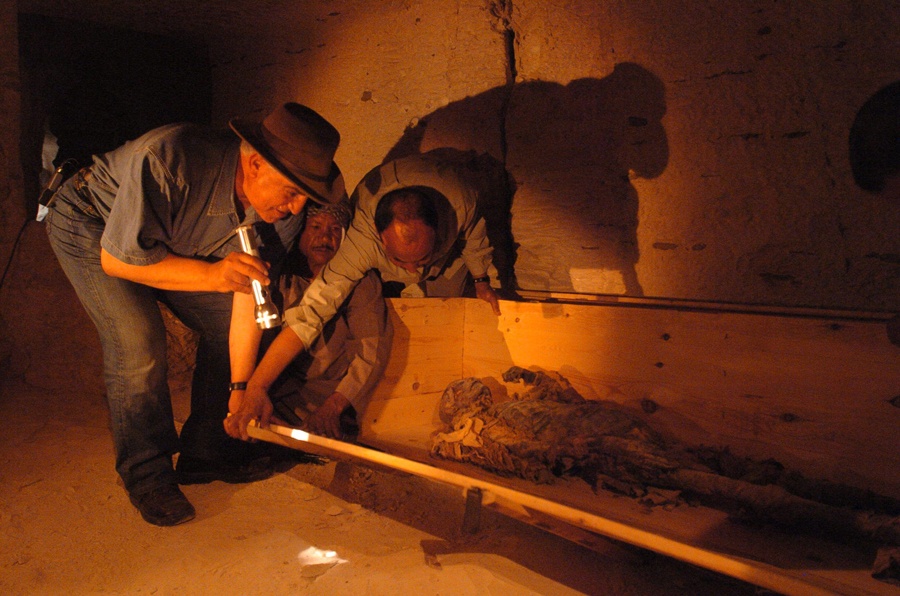
There are a number of unidentified high-status mummies of the New Kingdom,
mostly found in what we call the Royal Mummy Caches. These are a series of
secret tombs in the Valley of the Kings, in which agents of the High
Priests of Amun, who controlled the Theban area during the 21st and 22nd
Dynasties, hid the bodies of many of the kings and queens of the 18th,
19th, and 20th Dynasties. Although they may also have stripped both the
mummies and the royal tombs of most of their valuables, they also acted
piously, to protect the royal remains from the tomb robbers who roamed the
sacred hills of Thebes.
When we are studying the mummies from these caches, we have to keep in
mind that these mummies were moved at night, and we have to know that the
bodies could be misplaced and misidentified. When they were first taken
from their original tombs, most of the royal mummies were put in tombs
nearby. For example, we know from historical records that the mummy of
Ramesses II was originally moved from its tomb to the tomb of his father
Seti I. It was only afterward that it was moved to a cache at Deir el-Bahari.
This is very important to keep in mind when searching for the mummy of
Hatshepsut, because it shows how complicated the movements of these bodies
could be. The second thing to keep in mind is how the mummies could be
misidentified: When they were being transferred, the mummy of one king
could easily be placed in a coffin intended for another. The people
working for the priests identified the mummies through “dockets” written
in hieratic (a cursive form of hieroglyphs) on the coffin lids or the
linen shrouds with which they rewrapped the mummies, and it is easy to
imagine one mummy being mistaken for another. In addition, some mummies
have no identification at all associated with them any more.
This problem of identification is one of the reasons that I initiated the
Egyptian Mummy Project, the purpose of which is to study both royal and
non-royal mummies through CT scans. A portable machine was rented by
Discovery Channel from Siemens for the project; my hope was to use it,
among other things, to try to solve some of these puzzles of mistaken or
unknown identity, beginning with the riddle of Hatshepsut.
In my search for Hathshepsut,
the first thing that I did was look at the mummies from KV60, which is a
small, undecorated tomb located in front of KV20, the real tomb of
Hatshepsut. KV60 is actually a perfect cache for the reburial of mummies.
Howard Carter, the discoverer of the tomb of Tutankhamun, had excavated
this tomb in 1903, and found two mummies here: one, a small woman, was
found inside an 18th Dynasty coffin inscribed for a royal nurse, In; the
other was a hugely obese woman, discovered on the floor next to In’s
coffin. We know from other sources that Hatshepsut’s wet-nurse was named
Sitre-In, and that the last two letters of this name appeared on the
coffin from KV60; based on this fact, and the location of KV 60 close to
KV 20, Egyptologist Elizabeth Thomas had already suggested that the obese
mummy could be Hatshepsut.
KV 60 had been re-explored in 1906 by Edward Ayrton, and then left alone
until 1989, when Donald Ryan recleared the tomb. When Ryan began working,
there was only one mummy present in the tomb: the obese woman, whom he put
into a wooden box. I went to the Valley of the Kings to see her for
myself.
The tomb is very small, and is uninscribed. Its entrance is located
directly in front of KV19, the 20th Dynasty tomb of Prince
Mentuherkhepshef. KV 60 had clearly been robbed in antiquity; apart from
the mummies, only miscellaneous scattered remains were found inside,
including the lid of a wooden coffin, ancient tools, the remains of
pottery vessels, jewelry, scarabs, and seals. The only decorations are
wedjat eyes crudely painted in each of two niches that flank the entrance.
Architecturally, Ryan believes that KV 60 dates from the 20th Dynasty.
The obese mummy has its left hand across the chest with its fist clenched,
suggesting that it is a royal mummy (although there are non-royal mummies
with their hand in that position as well). She is bald in front but has
long hair in back, and is in very good condition. When I saw her, I
believed at once that she was royal, but had no real opinion as to who she
might be. I decided to bring this mummy to the Cairo Museum, so that she
could be studied and protected there.
Someone (perhaps Ayrton) had moved the coffin and mummy of the wet nurse
to the Cairo Museum. With the help of the curator in charge of mummies at
the museum, Someya Abdel Someia, I found them in storage on the third
floor. The manner of mummification was excellent, but to me her face and
features did not look particularly royal.
I then began to look at other unidentified New Kingdom female mummies that
might be royal. Two of these were found in the cache of royal mummies
found at Deir el-Bahari, DB320. This was discovered in about 1871 by a
local family, who kept their find a secret for a decade. In July of 1881,
the Egyptian Antiquities Department entered the tomb, and found about 40
mummies, including many of the great pharaohs of the New Kingdom, along
with the bodies of the 21st Dynasty family of the High Priest of Amun who
had been responsible for rescuing them from the Valley of the Kings.
Included among the mummies in this cache were Seqenenre Taa II, the great
warrior king of the 17th Dynasty who died in battle, his son Ahmose I and
grandson Amenhotep I, Thutmose II and III, and Ramses II. All of these
mummies are now in the Cairo Museum.
Now I had never even been inside this cache of the mummies, and I thought
that I needed to feel the site by entering the tomb. This is difficult
because the shaft leading to it is 15 meters deep. It was fascinating to
descend and then enter the narrow corridors and roughly cut burial
chamber, all of which had been crammed full of coffins, mummies, and
burial equipment.
The first mummy from DB320 in which I was interested is known as Unknown
Woman B (CG 61056 in the Cairo Museum). It is the mummy of an old lady.
People think that this mummy might be Tetisheri, the wife of Seqenenre Taa
I, and the mother of both Seqenenre Taa II and his queen Ahhotep. This
lady was not of royal origin but from the common people, and she lived at
a time when the Egyptian people were beginning their struggle for
independence against the Hyksos invaders. This mummy was found in the
cache inside a coffin dated to Dynasty 21 that had been inscribed with the
name of Ramesses I. (The mummy of Ramesses I was not there – a royal mummy
of the New Kingdom that many Egyptologists, including myself, believe to
be Ramesses I turned up several years ago in a museum in Niagara Falls.
This was bought by the Michael C. Carlos Museum, who gave it back to
Egypt.) The length of the mummy of Unknown Woman B is 157 cm. Her head is
bald in front, with the remaining white hair in curls with fake black
locks attached. Her ears are pierced for earrings, a common style of the
New Kingdom. The face is oval in shape, short, and with a pointed chin.
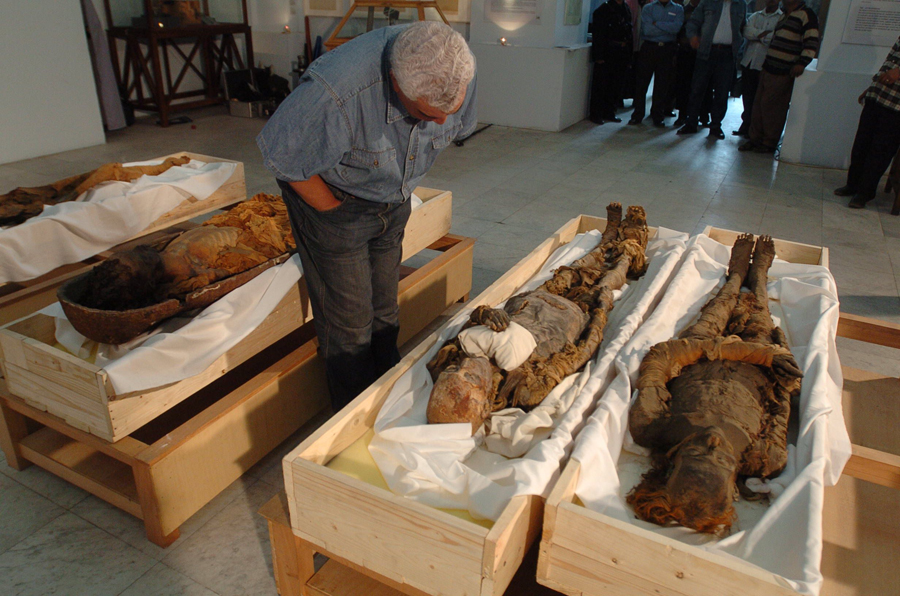
When it was discovered, the
mummy was covered with black resin, the residue from the funeral and
burial ceremonies. The head and the right arm of the mummy are broken.
Previous X-ray studies of this mummy focused only on her mouth and teeth.
The second mummy from DB320 is another elderly woman, Unknown Woman A (CG
61052). This was poorly preserved, and the mummification was not of the
highest quality. The upper teeth are lost, and there is no hair. Maspero
thought that it was the mummy of Meritamun, the daughter and wife of
Ramesses II from Dynasty 19. Some people who studied the mummification
style thought that it was not of royal origin and dated it to the Middle
Kingdom. Elliot Smith, who also studied this mummy, remarked that the
position of the body was very unusual. The head bends to the side, and the
two legs are crossed below the knees. The mouth is wide open. It may be
that she suffered some kind of trauma before death. The left leg is broken
in the front and the two arms were cut off, possibly by thieves, or maybe
by the people who moved this mummy from its original place to the DB320
cache. I planned to CT-scan both of these mummies.
Then it was time for me to go and see the original tomb of Hatshepsut,
KV20. I don’t think that many people have entered this tomb. Even
Egyptologists who have worked in the Valley of the Kings have avoided it,
because KV20 is one of the most difficult tombs in the valley to enter,
not least (as Howard Carter, who explored this tomb in modern tombs,
pointed out) because of the smell of bat droppings. People before Carter
knew the location of the tomb; it was described by Belzoni at the
beginning of the nineteenth century, and James Burton had cleared it to
the second stairway in 1824. In 1903-04, Carter cleared the tomb
completely, albeit with much difficulty, and came to the conclusion that
it was a double tomb for Hatshepsut and her father, Thutmose I.

The style of the tomb is
unique. It consists of a long curved tunnel carved in four sections, which
descends 210 meters into the bedrock before passing through a roughly cut,
undecorated antechamber and ending in a rectangular burial chamber with
three storerooms. The entrance passage begins by descending to the east,
then curves around to run north before swinging around to the west. It has
been suggested that this was done so that the burial chamber of the tomb
would be directly below the sanctuary of Hathshepsut’s temple on the east
side of the cliffs at Deir el-Bahari. Some people, however, believe that
the poor quality of the rock may have forced the architect to change the
tomb’s plan. The walls of the tomb were uninscribed, but in the burial
chamber were found about 15 pieces of limestone decorated with drawings
and inscriptions in red and black ink from the royal funerary book called
the Imy-Duat, or ”What is in the Netherworld.” These limestone slabs may
have been intended to replace decoration that could not be applied to the
walls because of the poor quality of the stone. Entering this tomb was
quite an adventure, because of the slippery descending tunnels and the
smell of the bats. To enter the burial chamber and see what was hidden
there, we had to open the blocks that sealed it
Carter found two sarcophaguses in the burial chamber: one for Hatshepsut
(now in the Cairo Museum), and the second, originally for Hatshepsut and
recarved for Thutmose I (now in Boston). No mummies were found, but
Hatshepsut’s canopic jars were here. In addition, Carter found the remains
of a shabti (funerary statuette), which looks like Hatshepsut, and may be
the only one still extant that belonged to her; stone vessels on which
were written the names of Thutmose I, Hatshepsut, and the grandmother of
the family, Ahmose Nefertari; pieces of faience; fragments of a head and a
small piece of a foot possibly from a guardian statue. One of the most
interesting artifacts connected with the queen, however, was found not in
her tomb but in the cache of the mummies in DB320. This was a wooden box
that bore the cartouches of Hatshepsut, which supposedly contained the
liver of the queen. This made me wonder whether we should be focused on
the DB 320 mummies: since this box was in the cache, this means that the
mummy should have been there as well, because the box would never have
been put there without the mummy.
Many scholars believe that it was Thutmose I who was responsible for the
construction of KV 20, and that Hatshepsut, who had built a tomb in Wadi
Sikket Taqa el-Zeide before she became pharaoh, needed a tomb in the
Valley of the Kings and wanted to be buried with her father. Others think
that it was Hatshepsut that built the tomb, and that she brought her
father from his original tomb, which has not yet been securely identified.
Later, it seems that Thutmose I’s grandson, Thutmose III, moved the king’s
body again, to a small tomb called KV 38. There is a mummy that was found
in DB320 in a coffin inscribed for Thutmose I, but scholars are not sure
that this is really this king: it has been argued that it cannot be the
father of queen Hatshepsut because it is too young, it does not look like
Thutmose II or III, and its arms are not in the proper “royal” position,
crossed at the chest.
After DB320, a second mummy cache, in this case of the Hight Priests of
Amun and their families, was found in 1891. A third cache was found in
1898, in the tomb of Amenhotep II (KV 35). In addition to more mummies of
great pharaohs, including Thutmose IV, Amenhotep III, and Ramesses III,
there were several unidentified female mummies discovered here. One, a
beautiful lady with long hair who has been nicknamed the Elder Woman
(although she was only about 40 when she died), is believed by many to be
Queen Tiye; the second is a younger woman who, it has been suggested,
could be queen Nefertiti, although this identification is highly unlikely,
as I had discovered through previous research. Another possible cache of
mummies were found in the tomb of Horemheb (KV 57), although the remains
here were skeletal and appear to have been lost.
We now had four mummies to CT-scan: the two from KV 60 and the two from
DB320. Our scientific team consisted of myself leading the search; my
assistant Hisham El-Leithy; radiologist Dr. Ashraf Selim; and Dr. Hany
Abdel Rahman Amer, a CT and MRI applications specialist with Siemens Ltd.
When we began our CT scans of the mummies of the unidentified ladies, only
three of them were in the Cairo Museum. The mummy of Unknown Woman A from
KV 60 was still in the Valley of the Kings. I had her mummy brought to the
Cairo Museum for this project. I am actually planning to make a room for
unidentified mummies in the Cairo Museum because each of them has a very
interesting story. For this project, we also scanned the mummies that are
believed to be most closely related to Hatshepsut: the mummy that might be
Thutmose I, Hatshepsut’s father; Thutmose II, her husband and probably her
brother; and Thutmose III, her stepson.
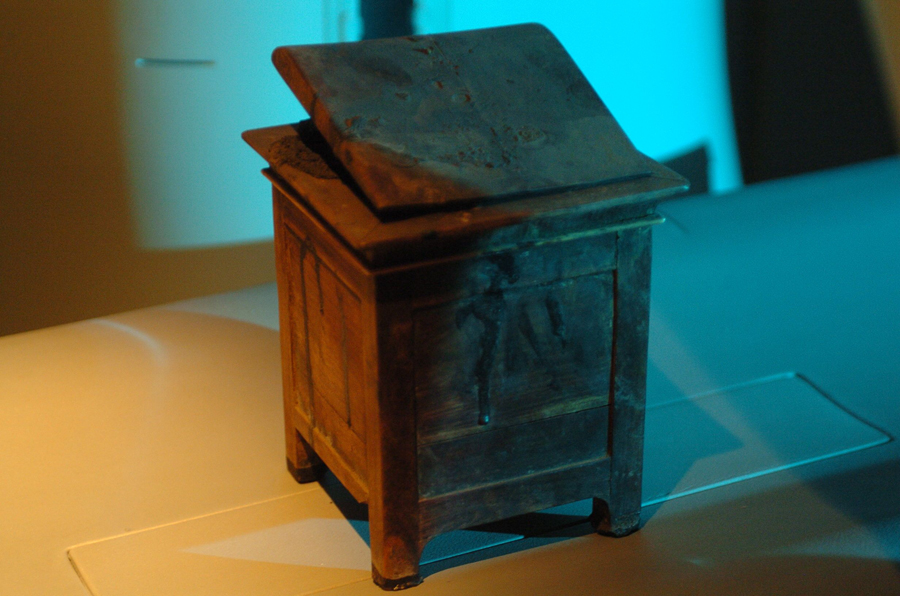
While I was doing these CT scans in the evening at the Cairo Museum, I
told Brando Quilici, the director of the Discovery Channel film on the
search for Hatshepsut, that it was very important also to scan some
objects from these tombs, to find out more about them. The first objects
that were brought to me were Hatshepsut’s canopic jars, and we put them
under the machine. The last thing that we scanned was the wooden box
bearing her cartouches that was found inside the DB320 cache.
It turned out that this box held the key to the riddle. To our surprise,
in addition to mummified viscera, there was a single tooth inside the box.
We know from other “embalming caches” that anything associated with a body
or its mummification became ritually charged, and had to be buried
properly. Therefore, it seemed that during the mummification of Queen
Hatshepsut, the embalmers put into the box anything that came loose from
the body during the mummification process. The other surprise in the box
confirmed this: it contained not only the liver but other, unidentified
organic material, probably from the queen’s body.
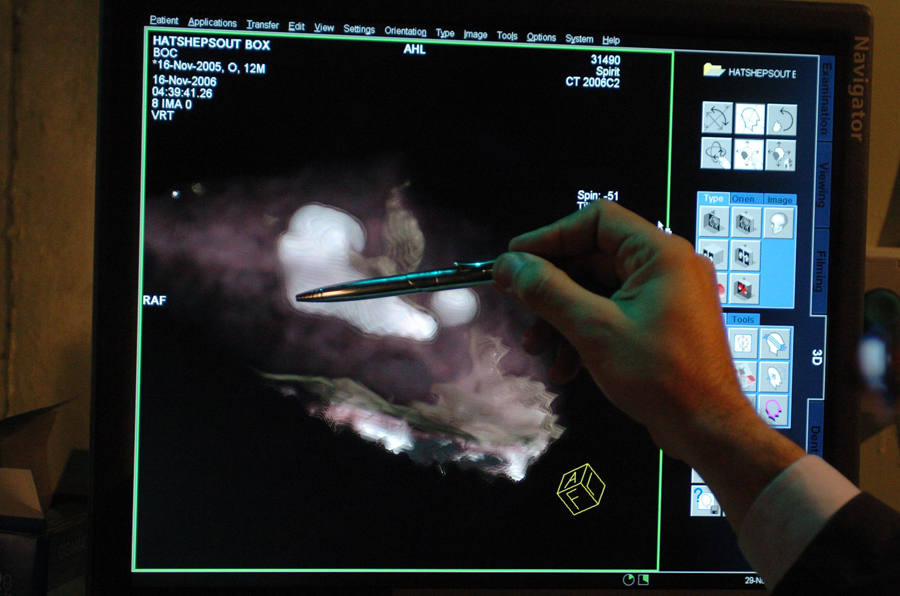
When I saw the tooth in the box I asked Dr. Ashraf Selim to bring in a
dentist right away. The dentist was a professor from Cairo University, Dr.
Galal El-Beheri. He began to study the tooth, and we went back to the CT
scans of all six of the unidentified female mummies, to see if any one of
them was missing a tooth. Not only was the fat lady from KV60 missing a
tooth, but the hole left behind and the type of tooth that was missing was
an exact match for the loose one in the box from DB320! We therefore have
scientific proof that this is the mummy of Queen Hatshepsut.
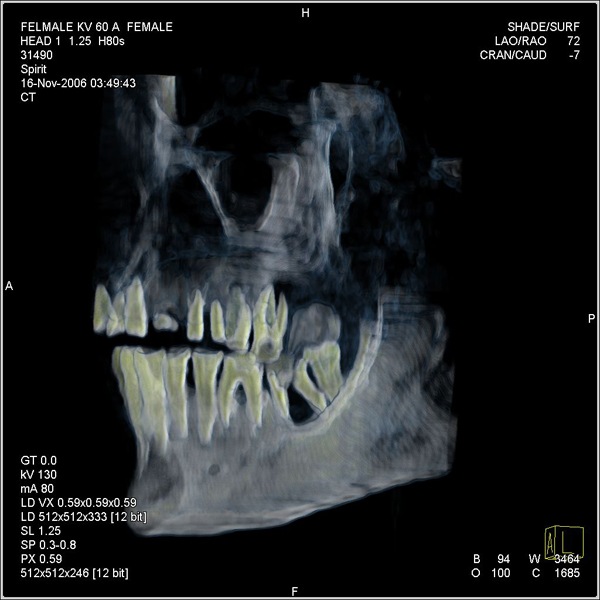
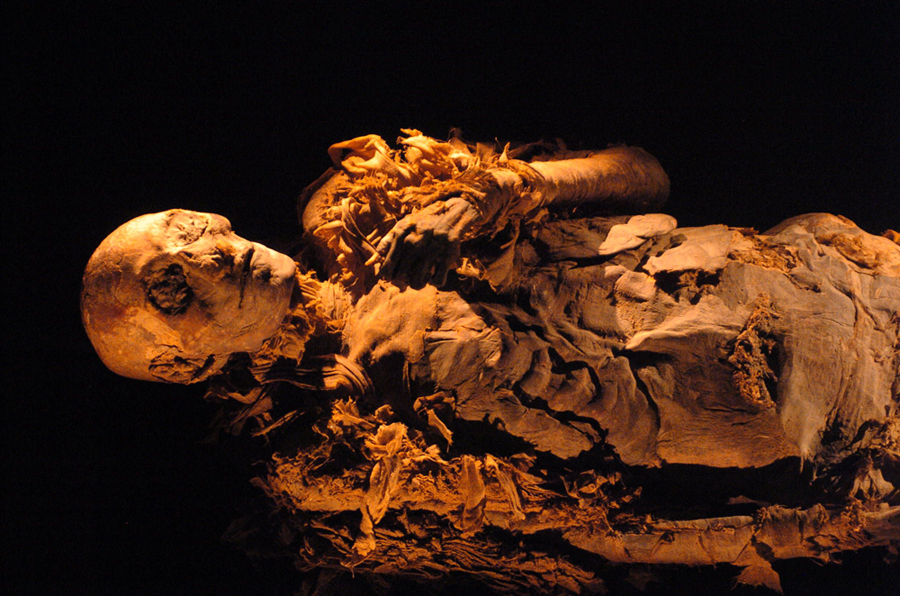
This discovery was not the only important result of my search for
Hatshepsut. Brando Quilici, the director from the Discovery Channel, and I
had a talk with the Discovery Channel. For the film, they built for us the
only DNA lab in the world that is dedicated exclusively to mummies. DNA
has never before been shown to be reliable for mummies, since it is hard
to get along enough sequence to learn anything useful, and it is very hard
to be sure that the sample has not been contaminated. My opinion is that
in order for such analysis to be worthwhile, we need a lab reserved
exclusively for mummy DNA. When you take a mummy and put it in another lab
that is used for other things, you can have a 40% rate of error in the
results due to contamination. For example, we have heard recently about
the DNA study of a mummy that was done in a museum in St. Louis. They
announced that the origin of this Egyptian mummy was European! For this
reason I wanted all of the DNA studies to be done by Egyptians, who were
well trained outside of the country in this field. When I could have a DNA
lab only for mummies at the Cairo Museum, and I could see that there were
some good Egyptian scholars that could do this work, I thought this would
be a good start. I believe that for the success of the project, and in
order to produce results that we can control, it is important that the
project should begin in Egypt, with Egyptian scholars. We have a person
from the National Research Center, Dr. Yehia Gad, who is in charge of our
new lab. The lab itself was built by the SCA, and the equipment was
brought in by the Discovery Channel from a company called Applied
Biosystems. The DNA lab is in the perfect location, the basement of the
Cairo Museum. Now we can say that we have at the Cairo Museum one of the
most remarkable scientific and archaeological facilities in the world with
the addition of the DNA and CT scan labs. It is important in archaeology
to use the most up-to-date scientific methods. Now, for the first time, we
can go inside the mummies and find out about their lives. We can learn
about their diseases and deaths from CT scans, and now with the DNA lab we
can find out about their family relationships, and possibly identify them
with certainty.
We decided that we would use this lab first to test DNA samples from
Hatshepsut, her great-grandmother Ahmose Nefertari, her father, Thutmose
I, and the wet-nurse, Sitre-In. DNA testing had been carried out on a
number of 18th Dynasty royal mummies in the mid-1990’s. The methods that
those researchers used were highly invasive. Nine different holes where
samples were taken by the previous researchers in the 1990’s were
identified in the mummy of Thutmose I by the current team. This time, we
used a much less invasive technique that relied on a bone marrow biopsy
needle. Multiple samples were obtained by entering the same puncture hole
from a number of different angles, minimizing damage to the mummies. The
great difficulty of using DNA to learn about ancient remains is that it is
fragile, and decays quickly. It is not at all easy to obtain a long enough
sequence from the genetic code of a mummy to tell anything useful about
it. Many people have expressed skepticism that it would be possible to get
a useful sequence from these mummies. However, using a new assay kit that
had been developed for forensic use and had only been on the market a few
months when we conducted our tests, we were able to retrieve and amplify
partial sequences of both mitochondrial DNA, which is passed from mother
to daughter, and more fragile nuclear DNA, which may be able to reveal
something about Hatshepsut’s relationship to the mummy known as Thutmose I
and the mummy of Thutmose II. Our genetic research is still progressing,
and it will take some time to perfect the procedures that we are using and
obtain complete results.
We hope to construct a second DNA lab at the National Research Center in
the Dokki area of Cairo, in which we can reproduce and verify our work in
order to produce the highest quality scientific results. In the meantime,
we are delighted finally to know that we have seen the face of Queen
Hatshepsut, and we are excited about the fascinating scientific
discoveries that we will make in the future by the use both of new
technology, and the kind of old-fashioned detective work (backed up by
state-of-the-art technology) that led me to connect a single loose tooth
in a box with the great female pharaoh, Hatshepsut.
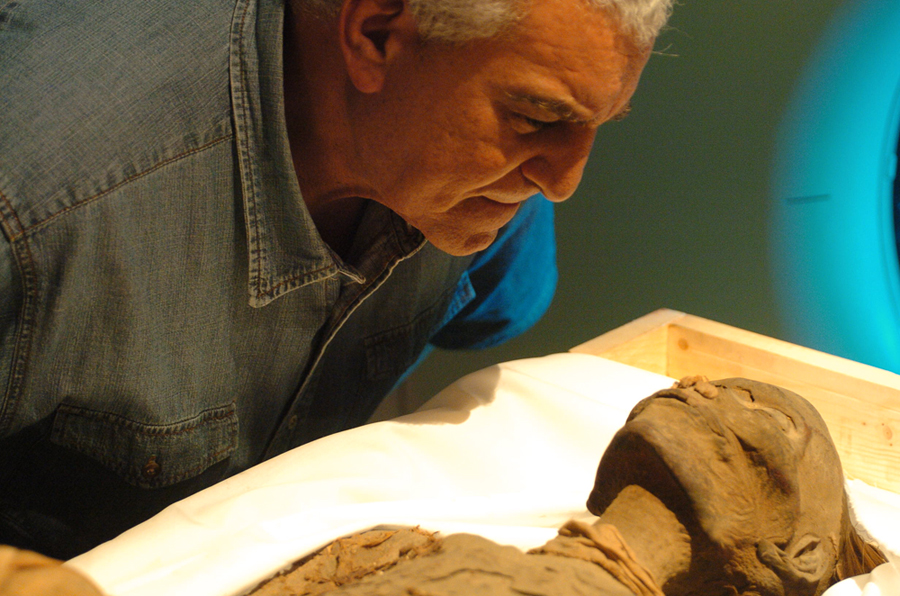
BACK
to The Plateau Homepage
|







